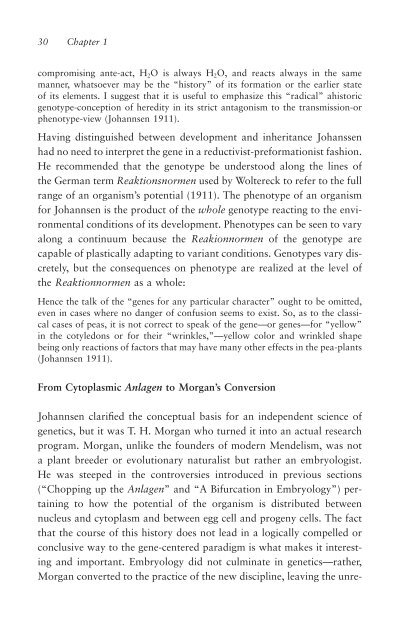A Critique of Pure (Genetic) Information
A Critique of Pure (Genetic) Information
A Critique of Pure (Genetic) Information
Create successful ePaper yourself
Turn your PDF publications into a flip-book with our unique Google optimized e-Paper software.
30 Chapter 1<br />
compromising ante-act, H 2O is always H 2O, and reacts always in the same<br />
manner, whatsoever may be the “history” <strong>of</strong> its formation or the earlier state<br />
<strong>of</strong> its elements. I suggest that it is useful to emphasize this “radical” ahistoric<br />
genotype-conception <strong>of</strong> heredity in its strict antagonism to the transmission-or<br />
phenotype-view (Johannsen 1911).<br />
Having distinguished between development and inheritance Johanssen<br />
had no need to interpret the gene in a reductivist-preformationist fashion.<br />
He recommended that the genotype be understood along the lines <strong>of</strong><br />
the German term Reaktionsnormen used by Woltereck to refer to the full<br />
range <strong>of</strong> an organism’s potential (1911). The phenotype <strong>of</strong> an organism<br />
for Johannsen is the product <strong>of</strong> the whole genotype reacting to the environmental<br />
conditions <strong>of</strong> its development. Phenotypes can be seen to vary<br />
along a continuum because the Reakionnormen <strong>of</strong> the genotype are<br />
capable <strong>of</strong> plastically adapting to variant conditions. Genotypes vary discretely,<br />
but the consequences on phenotype are realized at the level <strong>of</strong><br />
the Reaktionnormen as a whole:<br />
Hence the talk <strong>of</strong> the “genes for any particular character” ought to be omitted,<br />
even in cases where no danger <strong>of</strong> confusion seems to exist. So, as to the classical<br />
cases <strong>of</strong> peas, it is not correct to speak <strong>of</strong> the gene—or genes—for “yellow”<br />
in the cotyledons or for their “wrinkles,”—yellow color and wrinkled shape<br />
being only reactions <strong>of</strong> factors that may have many other effects in the pea-plants<br />
(Johannsen 1911).<br />
From Cytoplasmic Anlagen to Morgan’s Conversion<br />
Johannsen clarified the conceptual basis for an independent science <strong>of</strong><br />
genetics, but it was T. H. Morgan who turned it into an actual research<br />
program. Morgan, unlike the founders <strong>of</strong> modern Mendelism, was not<br />
a plant breeder or evolutionary naturalist but rather an embryologist.<br />
He was steeped in the controversies introduced in previous sections<br />
(“Chopping up the Anlagen” and “A Bifurcation in Embryology”) pertaining<br />
to how the potential <strong>of</strong> the organism is distributed between<br />
nucleus and cytoplasm and between egg cell and progeny cells. The fact<br />
that the course <strong>of</strong> this history does not lead in a logically compelled or<br />
conclusive way to the gene-centered paradigm is what makes it interesting<br />
and important. Embryology did not culminate in genetics—rather,<br />
Morgan converted to the practice <strong>of</strong> the new discipline, leaving the unre-
















